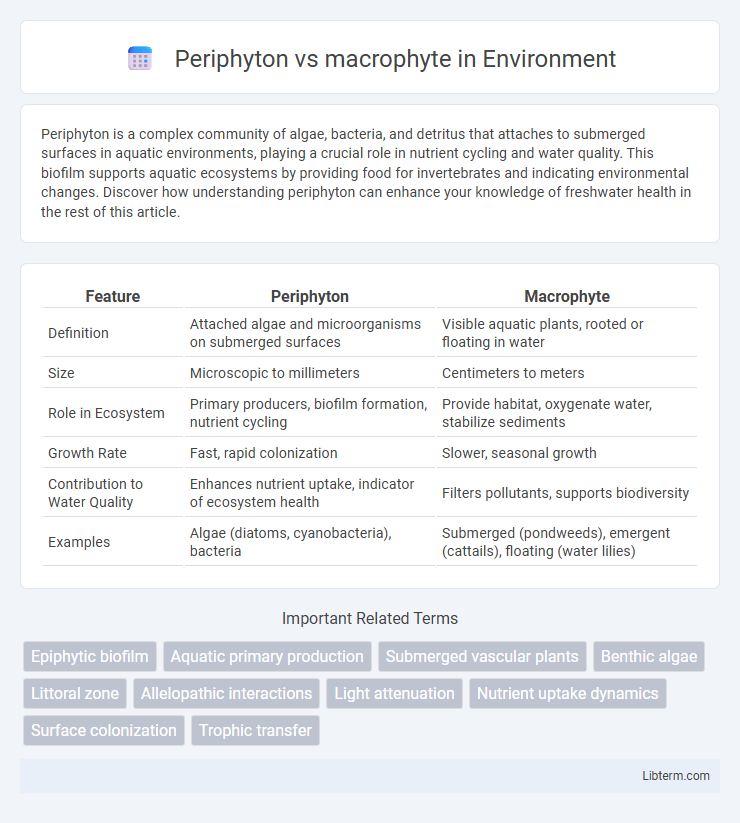Periphyton is a complex community of algae, bacteria, and detritus that attaches to submerged surfaces in aquatic environments, playing a crucial role in nutrient cycling and water quality. This biofilm supports aquatic ecosystems by providing food for invertebrates and indicating environmental changes. Discover how understanding periphyton can enhance your knowledge of freshwater health in the rest of this article.
Table of Comparison
| Feature | Periphyton | Macrophyte |
|---|---|---|
| Definition | Attached algae and microorganisms on submerged surfaces | Visible aquatic plants, rooted or floating in water |
| Size | Microscopic to millimeters | Centimeters to meters |
| Role in Ecosystem | Primary producers, biofilm formation, nutrient cycling | Provide habitat, oxygenate water, stabilize sediments |
| Growth Rate | Fast, rapid colonization | Slower, seasonal growth |
| Contribution to Water Quality | Enhances nutrient uptake, indicator of ecosystem health | Filters pollutants, supports biodiversity |
| Examples | Algae (diatoms, cyanobacteria), bacteria | Submerged (pondweeds), emergent (cattails), floating (water lilies) |
Introduction to Periphyton and Macrophytes
Periphyton consists of complex communities of algae, bacteria, fungi, and detritus that attach to submerged surfaces in aquatic ecosystems, playing a crucial role in nutrient cycling and primary production. Macrophytes are large aquatic plants, including submerged, emergent, and floating species, that provide habitat structure, influence water chemistry, and support diverse aquatic life. Both periphyton and macrophytes are essential components of freshwater ecosystems, contributing to ecosystem stability, biodiversity, and water quality.
Defining Periphyton: Structure and Composition
Periphyton is a complex assemblage of microscopic algae, bacteria, fungi, and detritus attached to submerged surfaces in aquatic environments, forming biofilms with diverse structural components. Unlike macrophytes, which are large vascular plants visible to the naked eye, periphyton consists predominantly of unicellular and filamentous organisms embedded within extracellular polymeric substances that provide stability and nutrient retention. This structural complexity enables periphyton to play a crucial role in nutrient cycling and habitat formation within freshwater and marine ecosystems.
Understanding Macrophytes: Types and Characteristics
Macrophytes are large aquatic plants categorized into submerged, floating, and emergent types, each exhibiting unique morphological traits such as extensive root systems or air-filled tissues for buoyancy. These plants play a critical role in aquatic ecosystems by providing habitat, oxygenating water, and stabilizing sediments. Unlike periphyton, which consists of microscopic algae and microbes attached to surfaces, macrophytes contribute significantly to nutrient cycling and water clarity through their substantial biomass and photosynthetic activity.
Ecological Roles of Periphyton and Macrophytes
Periphyton acts as a primary producer in aquatic ecosystems, contributing to nutrient cycling, oxygen production, and serving as a vital food source for invertebrates and fish. Macrophytes provide habitat complexity, stabilize sediments, improve water clarity, and support biodiversity by offering shelter and breeding grounds for various aquatic organisms. Both periphyton and macrophytes play crucial roles in maintaining ecosystem balance, influencing nutrient dynamics and trophic interactions in freshwater environments.
Habitat Preferences and Distribution Patterns
Periphyton thrive in well-lit, nutrient-rich waters, often colonizing submerged surfaces like rocks, plants, and sediments in both freshwater and marine ecosystems. Macrophytes prefer shallow, stable aquatic habitats with moderate to high light availability, commonly found in lakes, rivers, and wetlands where they anchor in sediment. Distribution patterns of periphyton are patchy and dynamic, influenced by water chemistry and flow, while macrophytes exhibit more stable, zoned distributions shaped by substrate type and water depth.
Nutrient Cycling and Water Quality Impacts
Periphyton plays a crucial role in nutrient cycling by rapidly absorbing and transforming dissolved nutrients such as nitrogen and phosphorus, thereby improving water quality through biofiltration. Macrophytes contribute to nutrient cycling by stabilizing sediments and providing habitat for microbial communities that facilitate nutrient uptake and recycling, which reduces nutrient loading and turbidity. Both periphyton and macrophytes enhance aquatic ecosystems by maintaining nutrient balance and supporting water clarity, but periphyton's faster growth rate allows for more immediate nutrient removal compared to the longer-term influence of macrophytes.
Interactions Between Periphyton and Macrophytes
Periphyton and macrophytes engage in complex interactions that influence aquatic ecosystem dynamics through nutrient cycling and habitat structuring. Periphyton communities develop on macrophyte surfaces, benefiting from increased substrate availability and light exposure shaped by macrophyte morphology. These interactions regulate competition for nutrients and light, impacting primary productivity and ecosystem stability in freshwater environments.
Methods for Assessing Periphyton and Macrophyte Communities
Methods for assessing periphyton communities primarily involve microscopic analysis, chlorophyll-a measurements, and biomass quantification through scraping techniques from submerged substrates. Macrophyte assessments commonly utilize field surveys with quadrat sampling, remote sensing, and biomass estimation through direct harvesting or allometric models. Both approaches prioritize spatial and temporal variability to accurately monitor aquatic ecosystem health and nutrient dynamics.
Applications in Aquatic Ecosystem Management
Periphyton and macrophytes play crucial roles in aquatic ecosystem management by enhancing water quality and providing habitat complexity. Periphyton, a biofilm of algae and microorganisms, is effective in nutrient uptake, making it valuable for bioremediation and controlling eutrophication in freshwater systems. Macrophytes contribute to sediment stabilization, oxygen production, and habitat provision, supporting biodiversity and facilitating natural water purification processes in wetlands and constructed aquatic environments.
Future Research Directions and Environmental Implications
Future research in periphyton and macrophyte ecosystems should explore their combined roles in nutrient cycling and habitat complexity under changing climate conditions. Investigating the resilience and adaptive mechanisms of periphyton versus macrophytes will improve management strategies for aquatic ecosystem restoration. Understanding differential responses to pollutants and eutrophication will enhance predictive models for maintaining water quality and biodiversity.
Periphyton Infographic

 libterm.com
libterm.com